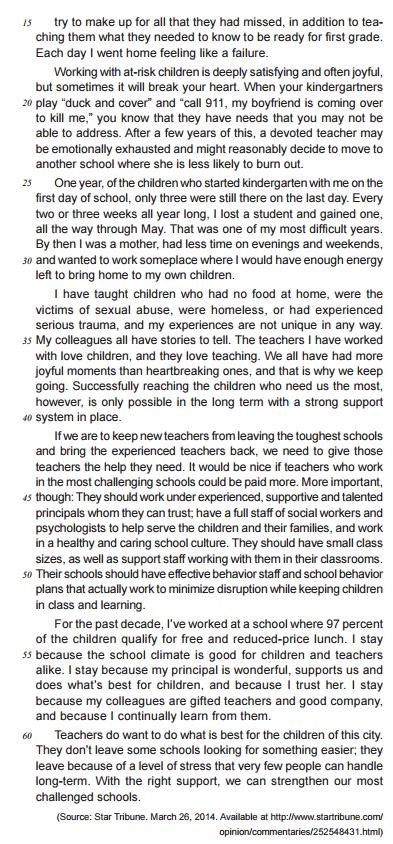Questions 21 through 35 address existing theories of English teaching.
Read them and mark the correct alternative.
The current state of the refl ections about language teaching is broadly associated to the idea of “postmethod”. This term was proposed by Kuramadivelu in 1994 and it includes ten macrostrategies. Three of these macrostrategies are:
Questions 21 through 35 address existing theories of English teaching.
Read them and mark the correct alternative.
The “Currículo Mínimo – Língua Estrangeira" (2012) aims at
promoting interdisciplinarity, majorly with the discipline of Portuguese
language. The document suggests that this promotion be achieved
by means of:
Questions 21 through 35 address existing theories of English teaching.
Read them and mark the correct alternative.
According to the “Parâmetros Curriculares Nacionais”, communicative competence is composed of the following three types of knowledge:
This editorial is a critical response to the article “Poor schools, rookie teachers” (l. 3). The critique is built against the logical relation established between the two noun phrases of this title. This logical relation is one of:
Adverbs present a range of semantic categories. In this text, we can fi nd some of them: time, manner, degree etc. The only pair that includes adverbs of different semantic categories is:
Questions 46 through 50 present some problems English learners
usually have. Mark the correct alternative for each question.
Consider the following sentence from a student’s essay.
“The theme of this short story make us see the beauty in another
vision.” (source: a real student’s essay)
The sentence should be rewritten as the following alternative:
Questions 21 through 35 address existing theories of English teaching.
Read them and mark the correct alternative.
The conceptual difference between “method” and “approach”
is an interesting point to start discussing English language teaching.
According to Richards and Rogers (2001), in “Approaches and
Methods in Language Teaching”, “method” and “approach” can be
translated into the two following phrases, respectively:
Questions 21 through 35 address existing theories of English teaching.
Read them and mark the correct alternative.
In language teaching studies, some attempts of modeling the reading process have been made. The approach to reading that is generally accepted today is:
Questions 21 through 35 address existing theories of English teaching.
Read them and mark the correct alternative.
“Scaffolding” (Nuttall, 1996, p.36) is a process that “focus on enabling students to develop”. In “Teaching Reading Skills in a Foreign Language”, Nuttall suggests some steps to promote this process. The alternative that presents one of these steps is:
According to the text, the only reason that fails to justify teachers leaving the toughest schools is that they:
This text shows several examples of multiple parallel clausal structures. One example particularly shows the repetition of subordinate clauses to describe the preceding noun phrase, producing a certain dramatic effect. The example is:
Questions 46 through 50 present some problems English learners
usually have. Mark the correct alternative for each question.
Consider the following noun phrase: ‘the only navigable river’.
Suppose a student asks you if there is a difference in meaning if
‘navigable’ is placed after ‘river’. The alternative with the correct
answer and comment is:
Questions 21 through 35 address existing theories of English teaching.
Read them and mark the correct alternative.
In the article “Ensino de Línguas: passado, presente e futuro”, Vilson Leffa (2012) predicts a certain “invisibility” to teachers in the future. According to the author, this “invisibility” means:
Questions 21 through 35 address existing theories of English teaching.
Read them and mark the correct alternative.
In “Ofi cina de Linguística Aplicada”, Moita Lopes (1996) discusses the concept of “self-fulfi lling prophecy”, presented by Rosenthal and Jacobson in 1973. The author particularly uses this concept to tackle the belief of failure, which:
Questions 21 through 35 address existing theories of English teaching.
Read them and mark the correct alternative.
Assuming that current language teaching tends to be eclectic in terms of approaches and that this might result in inconsistent and unfounded practice, Harmer (2007) recommends three essential elements for any teaching sequence: engage, study and activate. The alternative with a correct example of one of these elements is:



